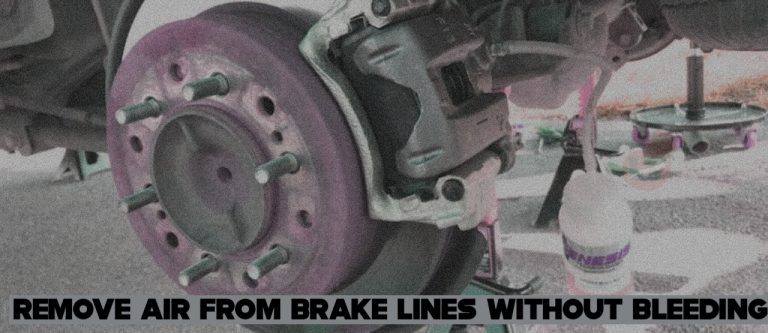This article entails how to get air out of brake lines without bleeding. Continue reading.
The brake system of a car is one of the most critical safety features of a vehicle. Using fluid pressure, the brake system transfers the force from your foot on the pedal to the wheels.
If air enters this fluid stream, it causes the high-pressure sections not to compress as much as needed for safe braking, posing a problem. Therefore, keeping air bubbles out of the brake lines is essential because it could affect efficiency and performance.
You might be a do-it-yourself kind of person and need a way to get air out of the brake lines without bleeding. If so, this article is the right one for you, as I will guide you on how to get air out of brake lines without bleeding.
Why do you need to remove air from your brake lines?
You need to remove air from your brake lines because the responsiveness of your brakes reduces once there is air in the brake lines. This can be dangerous, especially while driving on busy highways or when you suddenly get obstructed by an object on the road, because your brakes will worsen, making driving even more dangerous.
So, removing air from your brake lines will restore proper pressure and responsiveness to your car’s brake so that it’ll respond quicker and faster when applied.
Causes of Air Bubbles Brake Lines
Air can get into the brake lines of your vehicle through the following means:
1. An air bubble is created when a porous brake line contacts another part of the brake system. Even small amounts of trapped air create bubbles in your brakes’ hydraulic systems as pressure from your foot on the pedal squeezes the fluid and air together.
2. Air bubbles could also be created if the old fluid was not completely bled out of your car system during a brake job.
3. Some brake fluids absorb water over time, mainly when regularly used during cold weather, and this can create air bubbles when refilled with fresh fluid
Symptoms of Air in the Brake Lines
Some apparent signs tell you that you have air in your brake lines. The signs include:
1. Ineffective Brakes: Brakes won’t work when depressed.
2. Spongy Brake Pedal: This is when the brake pedal feels spongy when pressed down.
3. Loose Brake Pedal
How To Get Air Out Of Brake Lines Without Bleeding
To get air out of the brake lines of your vehicle, you have to take the following steps:
- Get your car on a flat surface and apply the parking brake.
- Open the hood of the vehicle and locate the master cylinder reservoir cap, which is octagonal or cyclically shaped and has an arrow that points to which wheel should be pumped first.
- Turn the reservoir cap in an anticlockwise manner until it ultimately comes off.
- Clean the cap and place it back on the reservoir, ensuring the arrow points to the wheel that should be pumped first. Repeat for the remaining three wheels so all the reservoir has their cap with an arrow pointing to them.
- Then, step slowly on each brake pedal for as long as possible until it becomes firm again or the air no longer comes out.
- Remove the reservoir cap from any master cylinders and slowly pour in fresh brake fluid until it gets below the brim of the tank. While doing this, ensure no air bubbles in the liquid by tilting the container slightly to enable it to rise to the top. Do this for the other master cylinders, if necessary.
- Start your car’s engine and press on each brake pedal to push out any excess air from the system. Do this many times until each brake pedal feels firm again, then test the brake to see if it works correctly and stop the engine.
That’s it.
FAQs
Conclusion
The brake system of a car is one of the most critical safety features of a vehicle. And when there is air in the brake lines, the braking action becomes ineffective and could be very dangerous. The above guide will enable the brake system to work correctly and safely.
RESOURCEFUL LINKS
— How to Reset Parking Brake Light
— Air Sound When Pressing Brake Pedal? Causes and Fix
As an Amazon Service LLC Program Associate, V. Auto Basics earns from qualifying purchases. See Our Affiliate disclaimer.
